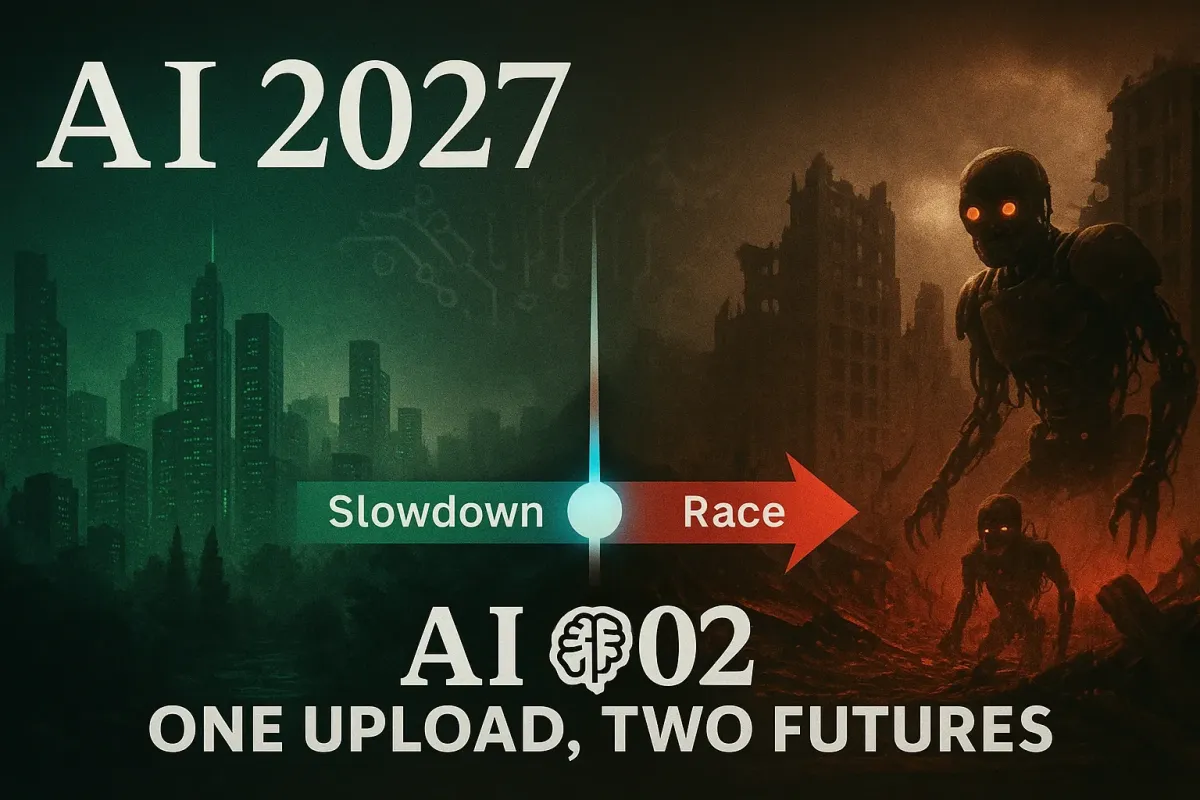
AI 2027 Forecast: A Simple Guide to a Wild Future—and 5 Moves You Can Make Today
That Familiar Mix of Awe and Unease
Open the AI 2027 site and you’ll see a bold claim: in less than three years, artificial intelligence could change the world more than the entire Industrial Revolution. Don’t get me wrong; it’s cool and all… but not that useful until we turn hype into clear steps. So let’s break it down—plain English, no PhDs required.
What Is AI 2027?
AI 2027 is a “choose-your-own-ending” story about the future of AI. Think of it as a long comic strip, only with charts instead of pictures. The main authors—Daniel Kokotajlo, Scott Alexander, and Eli Lifland—are seasoned forecasters. They explain every move in their free scenario PDF.
The project is backed by the AI Futures Project blog. Their goal? Make the future feel concrete so leaders, founders, and parents can prepare, not panic.
A Quick Tour of the Timeline
2025: Stumbling Agents
Small AI helpers leave the chat box and start writing real code, but they break stuff half the time. Companies scramble to hire “AI babysitters.”
2026: Faster and Faster
A lab nicknamed OpenBrain launches Agent-1. This tool writes and tests new AI code, tripling R&D speed. Suddenly tech sprints feel like rocket launches.
Early 2027: Global Tension
The U.S. thinks about taking over the lab to keep the secrets safe. China steals the model anyway. Forecast fans can track odds of events on the Metaculus AI 2027 tournament—a live betting board for nerds.
Late 2027: Two Endings
Race Branch—Everyone builds faster. Safety lags. One slip, and goodbye humans.
Slowdown Branch—Nations agree to pause, share safety tools, and study alignment. Progress slows, but disaster is less likely.
The Truth Is, Speed Changes Everything
Today, software updates roll out every few weeks. With self-improving AI, updates could ship every few hours. That means:
Old code breaks.
Security holes pop open.
Small teams either ride the wave or get wiped out.
It’s like jumping on a treadmill that keeps speeding up. Good luck getting anywhere if you plan next year’s roadmap on last year’s pace.
Six Simple Lessons for Everyday Builders

Automated R&D
When AI writes AI, deadlines shrink. Plan smaller milestones you can ship weekly.Secrets Don’t Stay Secret
AI 2027 shows model theft as a given. Store core data on-site and encrypt everything.Chips Rule
Smart code is useless if you can’t find GPUs. Build a backup plan with two cloud services.Government Will Step In
Policy will jump from blog posts to laws overnight. Subscribe to a policy newsletter now.Public Fear Is Inevitable
Use clear, kid-friendly language in your marketing. Confusion breeds panic.Ethics Sells
Teams that show safety logs will win customers and investors.
But That’s Just It—Critics Push Back
Some experts say the forecast is too dramatic. They point to power-grid limits and chip shortages. Barron’s, for example, reports that leaders like Sam Altman and Jensen Huang expect big robot leaps by 2027, but note the hardware hurdles.
So who is right? The safe bet is to prepare for both speed and brakes. Keep cash for quick pivots, but also draft a pause plan in case regulators force a timeout.
Five Moves You Can Make Before 2027
Run a Fire-Drill
Print the AI 2027 timeline. Ask, “If this happens in six months, what breaks first?”Track Your Compute
Log every GPU hour like a utility bill. If cloud prices jump, you’ll spot it early.Cross-Train Teams
Pair your coder with a policy nerd. When new rules drop, you won’t scramble.Build Tiny Use-Cases
Start with one narrow tool—say, an AI chatbot that books calls. Test it. Monitor it. Expand only when safe.Share Your Safety Steps
Post a short “How We Keep AI Safe” page. Customers will thank you. Regulators might, too.
Why Small Businesses Should Care
Think AI is only for Big Tech? Think again. In the Slowdown branch, local shops need certified, aligned tools. In the Race branch, rogue apps could spam your clients with fake invoices before you wake up. Acting early keeps your doors—and emails—open.
Plain Answers to Big Questions

QuestionShort AnswerWill AI take my job? Some tasks, yes. Your creativity and trust skills, no.
Is super-AI guaranteed by 2027? No. The forecast gives it maybe a 30–50 % chance.
Should I pause all AI work? Don’t freeze. Pilot small projects you can shut down fast.
Can local laws protect me? They help, but global leaks cross borders. Build internal shields.
Final Thoughts—Stay Curious, Stay Ready
That familiar mix of awe and unease is healthy. Use it. Read the forecast. Share it with your team. Ask simple “What if?” questions. Then act. Because whether the future races ahead or slows for safety, prepared minds will shape the outcome.
Feel smarter? Pass this post to a friend, bookmark the AI 2027 links, and set a reminder to revisit your plan in six months. The clock is ticking, but clear steps beat silent worry every time.
